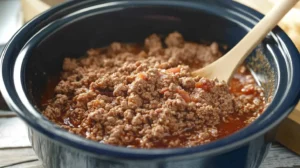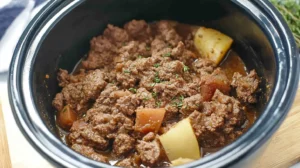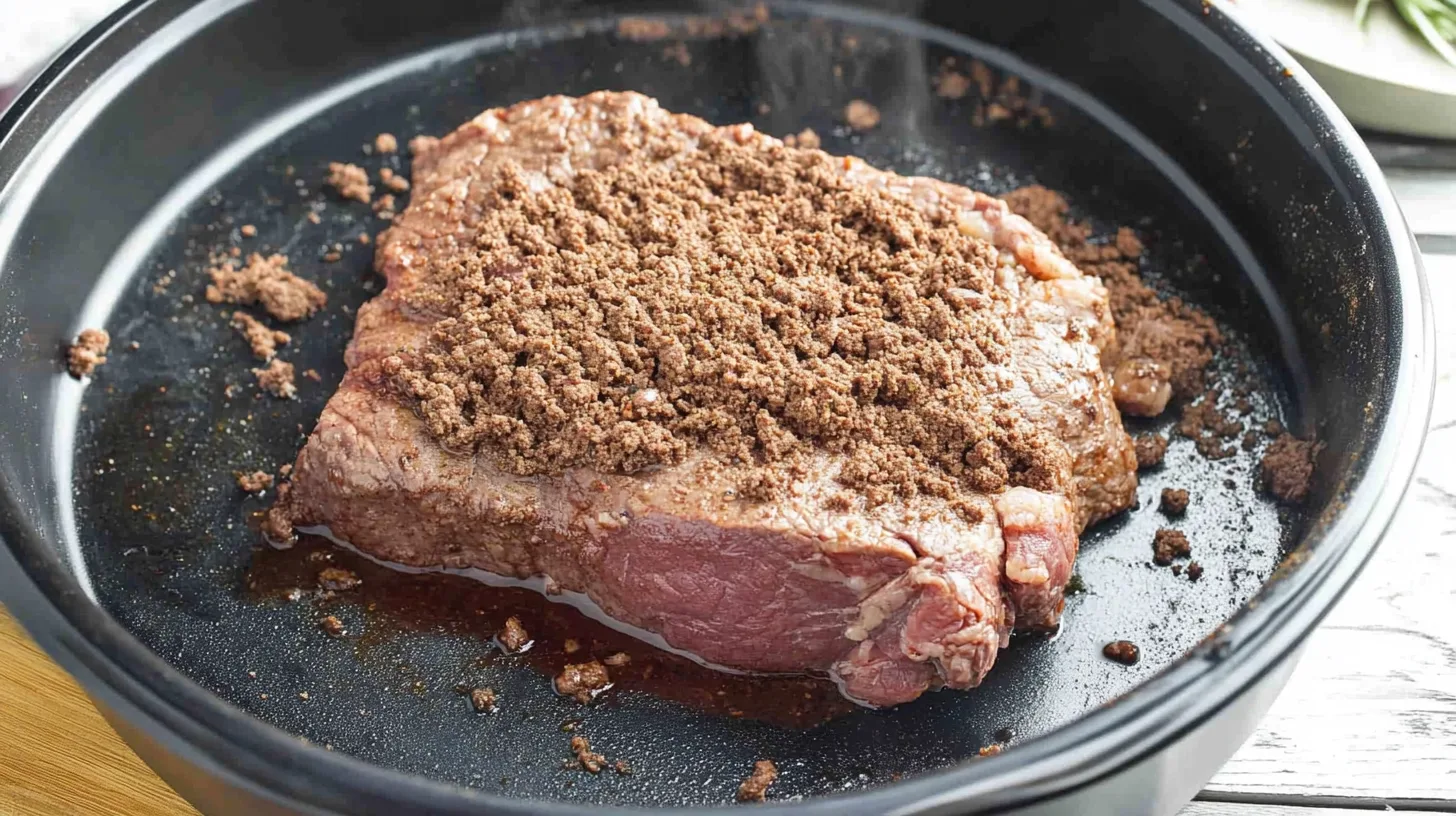When preparing a slow-cooked meal, the question arises: should you brown ground beef before slow cooker cooking? This simple decision can affect flavor, texture, and grease levels in your dish. Understanding when to brown ground beef before slow cooker recipes and how to do it correctly will help you create rich and satisfying meals.
What Does Browning Ground Beef Mean?
Definition of Browning
Browning ground beef is the process of cooking the meat at high heat in a skillet or pan until it develops a brown, caramelized surface. This change in color is due to the Maillard reaction, a chemical process that occurs when proteins and sugars in the meat are exposed to heat.
What Does Browning Ground Beef Mean?
Browning involves cooking meat on high heat to create a caramelized crust. For slow cooker recipes, understanding why you need to brown ground beef before slow cooker preparation is key. This process enhances flavor and helps the meat retain its texture during long cooking times.
Purpose of Browning in Recipes
Browning isn’t just about cooking the meat—it also enhances the flavor, giving it a savory, complex taste that blends beautifully with other ingredients. Additionally, it helps remove excess fat and ensures the ground beef maintains a better texture when combined with liquids.
Common Techniques for Browning
The most common way to brown ground beef involves heating a pan over medium-high heat, breaking the beef into small pieces, and stirring frequently until it’s evenly browned. Some cooks season the meat during this process, while others wait until it’s in the slow cooker.

Reasons to Brown Ground Beef Before a Slow Cooker
Enhancing Flavor
Browning the beef creates a rich, deep flavor that raw beef cannot provide. This added layer of complexity is especially noticeable in slow-cooked dishes, where the beef acts as a base for the entire meal. The caramelized bits formed during browning mix with the other ingredients to produce a savory umami profile.
Texture Improvement
Cooking ground beef beforehand helps preserve its texture. Raw ground beef can sometimes become mushy or overly soft when cooked for hours in a slow cooker. Browning it first gives the meat a firmer, more appetizing consistency.
Removing Excess Fat
Browning ground beef allows you to drain off excess grease, which can otherwise accumulate in your slow cooker. This is particularly useful when using fattier cuts of ground beef, as it prevents your dish from becoming overly oily.
Preventing Clumping
When ground beef is added raw to a slow cooker, it has a tendency to clump together. Browning breaks up the meat into smaller, more evenly distributed pieces, ensuring every bite is well-seasoned and delicious.
When Skipping Browning Is Okay
Situations Where Browning Isn’t Necessary
There are cases where skipping the browning step is acceptable. For example, if you’re short on time or aiming for a more straightforward preparation process, you can add raw ground beef directly to the slow cooker. This approach works best for recipes with strong seasonings, such as tacos or casseroles, where the dish’s other flavors compensate for the lack of browning.
Impact on Flavor and Texture
While skipping browning saves time, it may result in a slightly less robust flavor. The caramelization that occurs during browning significantly enhances the beef’s savory taste. Additionally, the texture may be softer and less defined, which might be fine for soups or stews but less desirable in structured dishes like shepherd’s pie.
Using Pre-Seasoned or Lean Ground Beef
If you use lean ground beef or pre-seasoned meat, the difference in flavor and texture when skipping browning may not be as noticeable. Lean ground beef has less fat, so there’s less grease to deal with, and pre-seasoned meat brings its own layers of flavor, reducing the reliance on browning.

Step-by-Step Guide to Browning Ground Beef
Choosing the Right Pan
Use a heavy-bottomed skillet or frying pan for even heat distribution. Cast iron is an excellent choice because it holds heat well, ensuring thorough browning.
Proper Heat Levels
Heat the pan over medium-high heat before adding the beef. A hot pan is crucial for searing the meat, which leads to proper browning. Avoid starting with a cold pan, as this can cause the meat to release water, leading to steaming instead of browning.
Techniques for Even Browning
- Break Up the Meat: Use a wooden spoon or spatula to break the ground beef into smaller pieces as it cooks.
- Don’t Overcrowd the Pan: Cook the meat in batches if necessary, as overcrowding can trap steam and hinder browning.
- Stir Occasionally: While frequent stirring ensures even cooking, allow the meat to sit undisturbed for short intervals to develop a caramelized crust.
Tips for Seasoning
Season the ground beef with salt, pepper, or other spices during or after browning. Adding seasoning early helps infuse the meat with flavor, while waiting until later allows you to adjust the taste according to the recipe.
Draining Excess Grease
Once the beef is browned, use a slotted spoon to transfer it to a plate or bowl, leaving behind any rendered fat in the pan. Alternatively, pour the fat into a heat-safe container for disposal.
Alternative Methods to Prepare Ground Beef for Slow Cookers
Using Raw Ground Beef Directly
If you prefer to skip browning, simply crumble the raw ground beef into the slow cooker. To prevent clumping, stir the beef occasionally during the first hour of cooking. Be aware that this method may produce more grease, which can be skimmed off later.
Pre-Cooking in Other Appliances
For convenience, you can use alternative appliances like:
- Microwave: Quickly cook ground beef in a microwave-safe dish, draining grease halfway through.
- Oven: Spread the beef on a baking sheet and bake at 375°F (190°C) until browned, stirring occasionally.
- Instant Pot: Use the sauté function to brown the beef directly in the Instant Pot before transitioning to slow-cook mode.
- Meat Substitutes and Preparation Differences
For vegetarian or plant-based dishes, you can use meat substitutes like textured vegetable protein or plant-based crumbles. These typically don’t require browning but can benefit from light sautéing to enhance flavor.

Recipes and Scenarios Where Browning Matters Most
Browning ground beef can significantly elevate certain dishes. Let’s explore some common recipes where this step makes a noticeable difference in flavor, texture, and presentation.
Chili
A well-browned base of ground beef adds a smoky depth to chili, complementing the spices like cumin, paprika, and chili powder. The browned bits left in the pan (fond) can be deglazed with broth or tomato sauce, enhancing the overall richness of the dish.
Spaghetti Sauce
Classic spaghetti sauces benefit greatly from browned ground beef, as it creates a savory foundation for the tangy tomato-based sauce. The caramelized crust on the beef integrates seamlessly with Italian herbs like oregano and basil, resulting in a harmonious blend of flavors.
Shepherd’s Pie
For shepherd’s pie, the texture of browned ground beef is essential. The meat layer remains firm and defined beneath the mashed potatoes, creating a contrast in consistency that elevates the dish’s appeal.
Casseroles
Many casseroles, such as tater tot or pasta bakes, rely on ground beef as a primary ingredient. Browning the meat ensures it doesn’t release excess grease during baking and prevents the final dish from becoming overly oily.
Tacos and Burritos
Browning ground beef for taco filling enhances the flavor and helps the spices adhere better. The slight crispiness achieved during browning adds a satisfying texture that raw beef can’t provide.
Pros and Cons of Browning Ground Beef
Pros
- Enhanced Flavor: Browning creates a more complex and savory taste.
- Improved Texture: The meat maintains a firmer structure, avoiding mushiness.
- Reduced Grease: Excess fat can be drained, resulting in a healthier dish.
- Aesthetic Appeal: The caramelized surface gives the beef a more appetizing appearance.
Cons
- Time and Effort: Browning adds an extra step to meal preparation, which might be inconvenient for busy cooks.
- Energy Consumption: Using an additional pan increases energy usage and requires more cleanup.
- Potential for Overcooking: If not carefully monitored, the meat can become dry or overdone during browning.
Tools and Tips for Perfect Ground Beef Preparation
To achieve optimal results when preparing ground beef, having the right tools and techniques is crucial.
Essential Utensils
- Non-Stick or Cast-Iron Pan: Ensures even cooking and prevents sticking.
- Wooden Spoon or Spatula: Helps break up the meat into uniform pieces.
- Slotted Spoon: Ideal for draining excess fat.
- Grease Container: A heat-safe container for safely disposing of rendered fat.
Common Mistakes to Avoid
- Overcrowding the Pan: Leads to steaming instead of browning.
- Insufficient Heat: A cold or lukewarm pan prevents proper caramelization.
- Skipping Draining: Leaving excess grease can make the final dish overly oily.
Storing Browned Ground Beef
Browning ground beef in advance can save time during meal prep. Store it in an airtight container in the refrigerator for up to 3 days, or freeze it for up to 3 months. Label the container with the date and type of seasoning for easy reference
FAQs: Common Questions About Browning Ground Beef
Can I Brown Ground Beef in Advance?
Yes, browning ground beef ahead of time is a great way to streamline meal preparation. Cook the beef, let it cool, and store it in an airtight container in the refrigerator or freezer. When you’re ready to cook, simply add it to your slow cooker or recipe.
Does Browning Affect Nutrition?
Browning ground beef doesn’t significantly alter its nutritional content. However, draining the fat after browning can reduce the calorie and fat content, making the dish healthier. The Maillard reaction during browning does slightly change the protein structure but mainly enhances flavor.
How Do I Prevent the Meat from Sticking or Burning?
To prevent sticking:
- Use a well-oiled non-stick or cast-iron skillet.
- Ensure the pan is hot before adding the beef.
- Stir occasionally but allow the beef to sit undisturbed at intervals to brown properly.
Can I Add Browned Beef to a Cold Slow Cooker?
It’s safe to add browned beef to a cold slow cooker, but preheating the slow cooker is recommended for better cooking efficiency. If the slow cooker is cold, it may take longer for the dish to reach a safe cooking temperature.
Do I Need to Brown Ground Beef for Every Slow Cooker Recipe?
Not necessarily. While browning improves flavor and texture, some recipes—like soups or stews—might not require it, especially if they have bold seasonings or are cooked for long durations.
Is It Safe to Cook Raw Ground Beef in a Slow Cooker?
Yes, it’s safe to cook raw ground beef in a slow cooker as long as the dish reaches an internal temperature of 160°F (71°C). Stirring the meat during the initial cooking stages can help it cook evenly.
Conclusion
Browning ground beef before adding it to a slow cooker is a simple step that can greatly enhance the flavor, texture, and presentation of your dish. While it’s not always strictly necessary, this extra effort is particularly beneficial for recipes where ground beef serves as the star ingredient. On the other hand, skipping this step may be acceptable for time-saving purposes or when using recipes with rich seasonings or lean beef.
By understanding the techniques and knowing when to brown (or not), you can tailor your cooking process to suit the recipe, your schedule, and your taste preferences. Whether you’re preparing a hearty chili, a creamy casserole, or a flavorful spaghetti sauce, browning your beef is a valuable skill that will elevate your slow-cooked meals to new heights.Now that you have all the information, it’s time to get cooking and enjoy the delicious results of your efforts!
recipes
Do I have to brown ground beef before slow cooker?
- Total Time: 12 minutes
- Yield: 1 lb cooked ground beef 1x
Description
Ground beef is a versatile ingredient that adds rich flavor to slow cooker meals. However, before adding it to your slow cooker, it’s essential to brown it properly to enhance texture, prevent excess grease, and improve the overall taste of your dish. Pre-cooking ground beef also helps reduce food safety concerns by ensuring even cooking.
Ingredients
- 1 lb ground beef
- 1 tbsp olive oil (optional)
- ½ tsp salt (adjust to taste)
- ½ tsp black pepper
- ½ tsp garlic powder (optional)
- ½ tsp onion powder (optional)
Instructions
- Heat a Pan: Place a large skillet over medium-high heat and add olive oil if using.
- Add Ground Beef: Break the ground beef into small chunks and spread it evenly in the pan.
- Season It: Sprinkle salt, pepper, and any optional seasonings for enhanced flavor.
- Brown the Meat: Cook for 5-7 minutes, stirring occasionally, until the beef is no longer pink and has a brown, crumbly texture.
- Drain Excess Fat: Use a slotted spoon to transfer the beef to a plate lined with paper towels to remove excess grease.
- Transfer to Slow Cooker: Add the browned ground beef to your slow cooker and proceed with your recipe.
Notes
- Browning ground beef before adding it to the slow cooker prevents clumping and enhances flavor.
- If using lean ground beef (90% lean or higher), you may not need to drain much fat.
- For extra flavor, sauté onions and garlic with the beef before adding it to the slow cooker.
- Consider freezing browned ground beef in portions for quick meal prep.
- Prep Time: 5 minutes
- Cook Time: 7 minutes
- Category: Meal Prep, Basics
- Method: Stovetop
- Cuisine: American
Nutrition
- Serving Size: ¼ lb
- Calories: 250
- Sugar: 0g
- Sodium: 75mg
- Fat: 17g
- Saturated Fat: 6g
- Unsaturated Fat: 10g
- Trans Fat: 0g
- Carbohydrates: 0g
- Fiber: 0g
- Protein: 22g
- Cholesterol: 65mg
Keywords: ground beef, slow cooker, browned beef, meal prep, cooking basics

